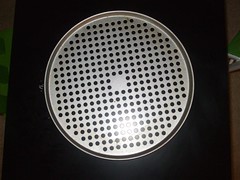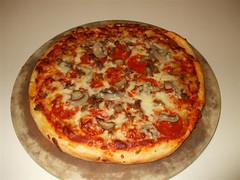Several months ago I got some high gluten flour from GFS Marketplace. It isn’t the same brand as the one pictured, but I’m not sure if brand matters? I finally got a chance to try it out a week ago. Since I got a 25 pound bag, I have plenty to experiment with, but I haven’t deviated from my original recipe yet. I’m just trying to get a consistent crust.
Cooking Methods
With basic bread flour I’ve tried pizzas on a pizza stone with cornmeal, a deep dish pan with shortening or extra virgin olive oil, and a perforated pan. I can’t seem to get the ones in an oiled pan to be as crispy as I’ve liked, almost like it’s not cooked in the same amount of time. Perhaps the temperature needs to be higher. The texture of the ones cooked in cornmeal seem like the most professional.
High Gluten
The high gluten flour wasn’t much harder to knead than I was used to (I was warned it would be tougher since the gluten strands develop more). It also wasn’t much harder to roll out. I’ve learned to be more patient and let it rest and get up to room temperature after its retardation time in the fridge. I’m now trying to spin the dough to help spread it out, but for some reason it gets oblong shaped and I’m not sure how to correct that except with hand pressing and a rolling pin. I have a nice 2 sided rolling pin that seems to work really well. I’ll blog about that one and my other utensils in a future post.

